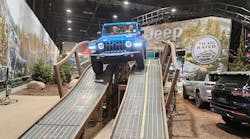The adage that dealers sell the products they have today, and don’t put much faith in what is coming down the road, was reinforced at the North American International Auto Show in Detroit, which opened last week with two media-only days. Mainstream manufacturers gave their full support by touting gasoline models at almost every turn.
Ford started the festivities the night before by introducing their updated F-150 pickup, with gasoline horsepower, torque and up-trims at the top of the features list. Ford also talked about their PowerBoost Hybrid and how they were ramping up production.
Cadillac kicked off press day by highlighting the 2025 CT5 sedan. Pitch points discussed turbo versions with plenty of horsepower, safety features and a potential Blackwing edition. Unfortunately, from 10 feet away the model looks like the 2023 version.
Shortly after, GMC came out of the blocks by introducing the 2024 Acadia. The mid-size SUV is larger than today’s version and comes with Super Cruise driver support. Forget electric; the entry does not even have a hybrid version. Both GM divisions appeared to have phoned in their presentations.
Jeep brought out all the marketing tools to present the 2024 Gladiator (gas-powered, no hybrid). The advertising and emotional pitches on the big screen introduced two new trims and banged the drum hard on Gladiator’s off-road capabilities. Jeep also indicated they would be 50% all-electric by the end of the decade.
Overall, the four presentations, and the preponderance of vehicles on the floor, were gasoline models—exactly what dealers are looking for today, and through the balance of the decade. Manufacturers, too, because that is where profits are generated.
The gasoline models that stood out included the new Buick Envista SUV with “gotta-have” styling, Toyota’s Crown sedan, and Ford’s Mustang GTD (for those consumers with the big bucks).
The Missed Opportunity: Battery-Electric Models Played Second Fiddle
Pitches for the electric vision seemed out of place. There are at least 10 mainstream BEVs that will be launched over the next 18 months that were not at the show (or mentioned). Most notable are the 2024 Buick Electra, 2024 Jeep Recon and Cadillac’s Escalade IQ, coming next year. Unfortunately, the most significant change in mainstream vehicle offerings to the Midwest did not fit the vibe of the dealer-centric show.
Sure, there were test tracks where journalists could pretend they were electric vehicle customers and go for a ride-along experience (you were not allowed to drive the vehicles). Journalists had to wait about 10-15 minutes to take their five-minute ride. Consumers at the show will probably have to wait 30 minutes to take their ride. With that amount of waiting time, they will opt for the Jeep or Bronco ride demonstrating off-road climbing power over carnival-like structures. That test-ride experience was much more fun.
There were a few BEV standouts on the floor. The most significant was the Equinox EV. The size and expected price of the vehicle will make it a volume hit. Additionally, the 2025 Ram REV stood out with new sheet metal, 500 mile range and an exceptional interior. The rumor mill during the day teased that the Escalade IQ and VW’s ID. Buzz van would only be shown on consumer days. Hopefully!
It is not a secret that the heartland of America has not fully accepted the battery-electric value proposition. So, what better opportunity to tout where the market is heading---right in the Motor City. Fleet customers already understand the benefits of BEVs given their business applications. They don’t need an Autoshow to sway their decisions.
Mainstream retail customers are different. They need continuous purchase reinforcement, either by attending the show, or hearing about the benefits from the automotive press---or their favorite dealer.
There is no such thing as too much BEV hype when you are trying to alter the direction of the automotive industry. Marketing and PR types should never miss an opportunity to promote BEVs.
Why is this communication process important? Because legacy manufacturers need to pick up the sales pace in North America. Tesla’s significant sales growth has made it easy for analysts to promote EV performance in North America. Yet, Tesla’s sales performance will not be the real measure of BEV success. That will be measured by the BEV sales growth of the Detroit 3, and other legacy brands. Good news: these brands have the heartland distribution numbers to make this transition happen.
These mainstream brands have plenty of unfinished business. Today, mainstream battery-electric success is very low given BEVs’ expected 2023 market share of 28.1%. To correct the sales weakness, mainstream BEV entries will jump to 79 by 2026 and 104 by 2030.
Their sales growth must come from a product and communications offensive. Tesla and the startups are not going to just hand them 56.3% of sales.
The road to more BEV sales is filled with potholes. It can be made smoother when manufacturers promote BEV products at these events, even if it will take time for dealers and suppliers to reap the benefits.
Consumers look to auto show reporting to determine what’s hot. Mainstream manufacturers missed the biggest auto show in the heartland to communicate to journalists. I hope that consumer days provide more BEV hype.
Consumers will know that the time is right to visit their dealer and buy an electric when future auto shows relegate ICE vehicles to the basement of the Huntington Center next to the T-shirts and sunglasses. Unfortunately, it didn’t happen this year.
Warren Browne is President of WP Browne Consulting LLC, and is adjunct professor of economics and trade at Lawrence Technological University.




